I love nonfiction, both reading it and writing it, so I’m delighted and honored to be a guest today on Picture Book Builders, one of my very favorite blogs—thanks, Jill!
I have a deep love of the natural world and the creatures who live in it, and I aim to celebrate nature’s wonders in my nonfiction writing.
Today, I’ll be talking a bit about how I approach writing narrative vs. expository, in particular, STEM-based nonfiction. I have two titles out in 2020, Whoo-Ku Haiku, a narrative nonfiction picture book about a Great horned owl family written as a series of haiku poems, illustrated by Jonathan Voss (GP Putnam’s Sons), and Play Like an Animal, an expository nonfiction picture book about animal play, illustrated by Mia Powell (Millbrook Press).
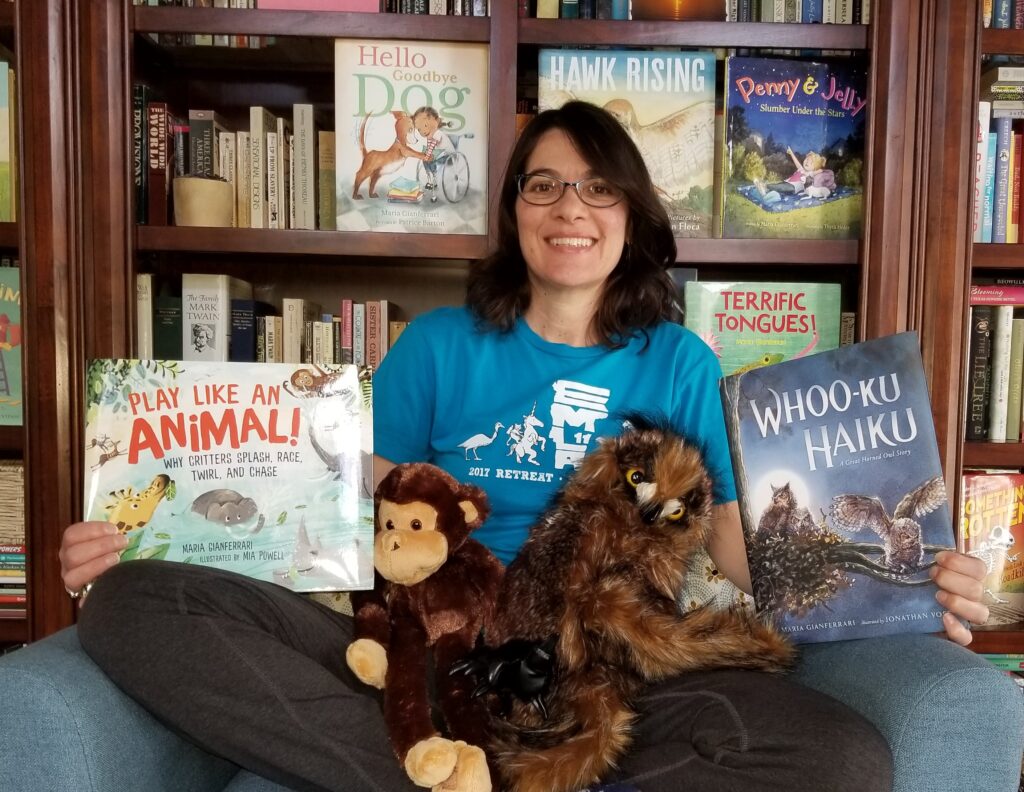
In general, my narrative nonfiction books like Whoo-Ku Haiku, Hawk Rising and Coyote Moon tend to be more lyrical and poetic in voice and approach, using sensory language. My expository titles, Play Like an Animal, and Terrific Tongues, use more lively language and have more of an interactive feel.
For narrative projects, I tend to think more in terms of arc and scene, and all three have a time-based structure. Both Coyote Moon and Hawk Rising, for example, have a circular story and a nocturnal/diurnal structure, while Whoo-Ku uses a longer, seasonal structure. The story begins with winter nesting of the Great horned owl mates:
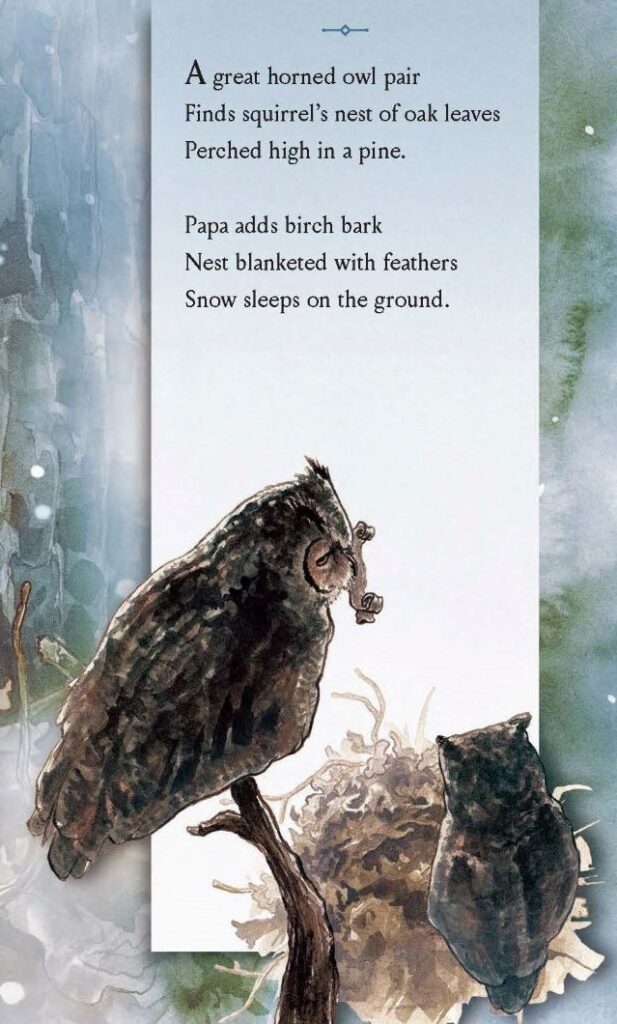
And ends with the autumn fledging of the owlets.
Each individual haiku is a contained scene—some are calm and quiet like this one:
Mama lays an egg.
In the starlight it glistens.
A moon of its own.
Others are full of danger and drama—a hawk hovering over the owlets before Mama owl saves the day:
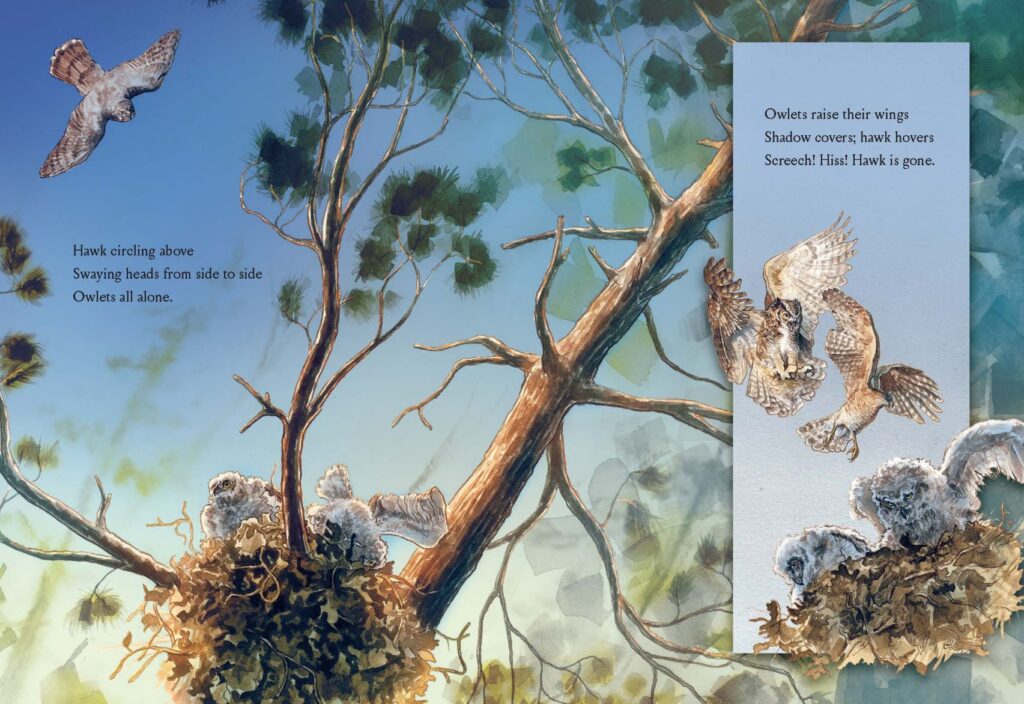
My goal was to add dramatic tension both within an individual haiku, and cumulatively as a series of moments within the whole narrative structure, the climax being when one of the branching owlets falls from the nest, as a hungry red fox paces below:
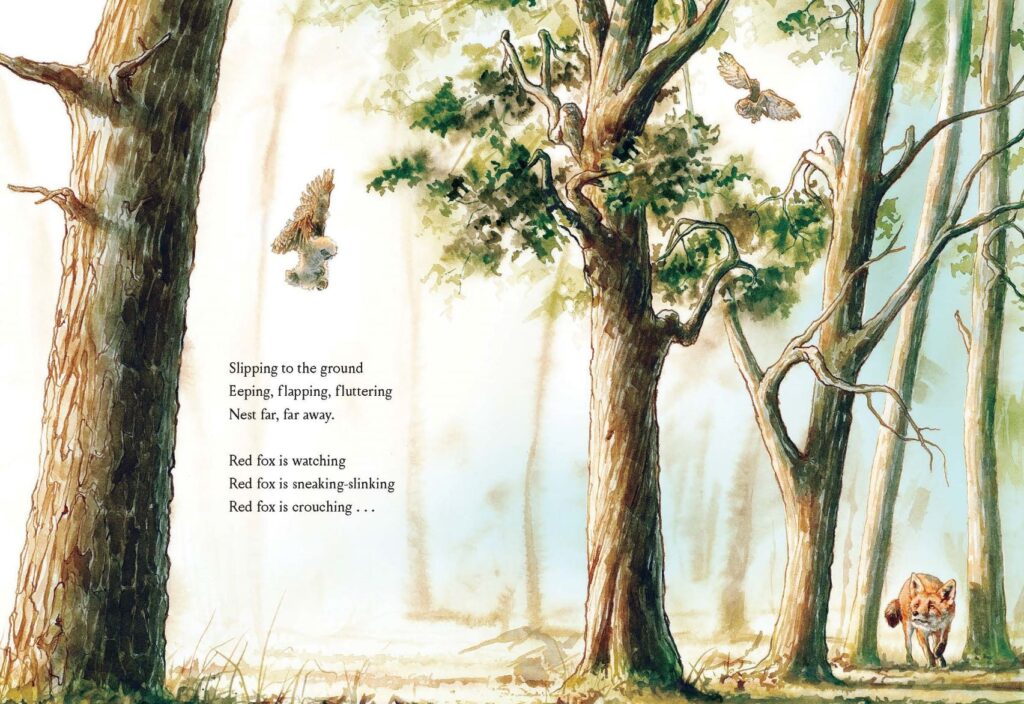
Jonathan Voss’s gorgeous illustrations are highly atmospheric, and his insets and bold use of perspective add additional drama to the visual voice and storytelling.
Play Like an Animal, on the other hand, does not have a narrative structure. It’s a work of expository or informational nonfiction and its structure is concept-based, in this case focusing on the different ways that animals, and kids, by extrapolation, play.
As a whole the book celebrates play of all kinds and invites kid readers to imagine how they can play like animals using action-oriented verbs.
Race and chase like a monkey
Box like a kangaroo
Wrestle like a rat
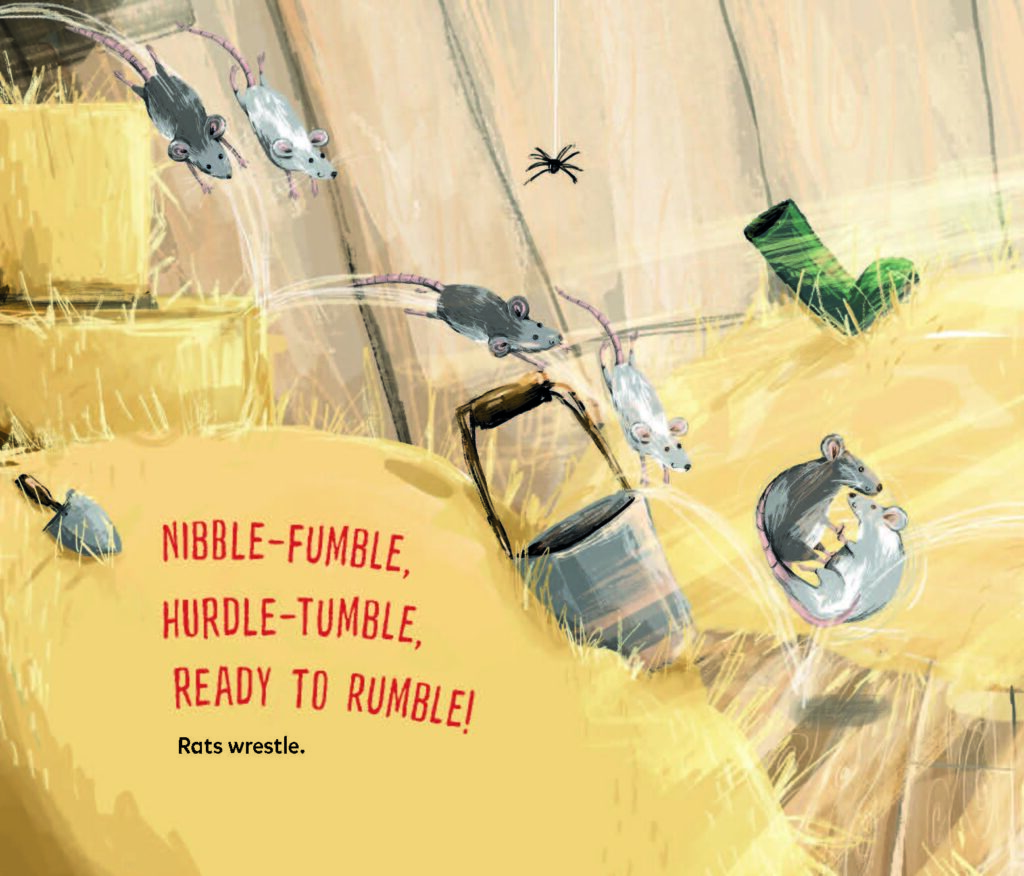
Some of the spreads focus on one type of animal, such as those mentioned above, where other spreads show how different types of creatures play using the same kind of medium. For example,
Peccaries plop
And rhinos rub in the mud;
Ravens slip, slide, sled
River otters belly-slide, flip, glide in snow.
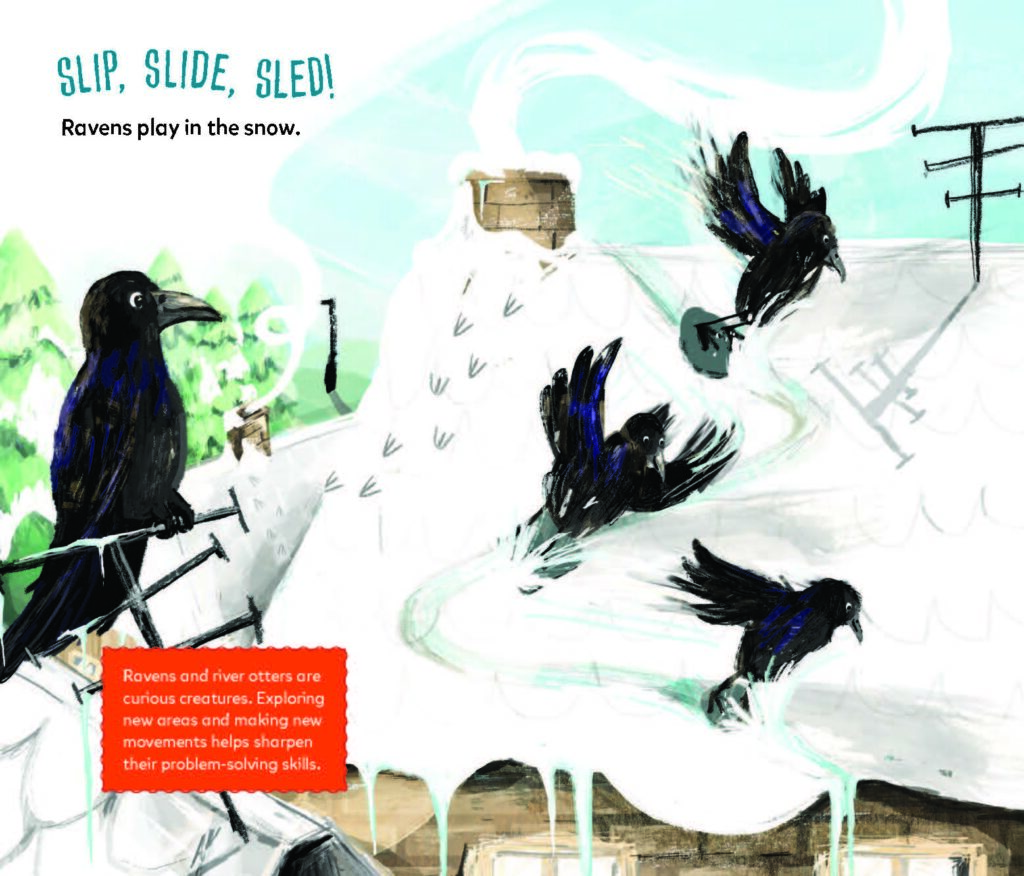
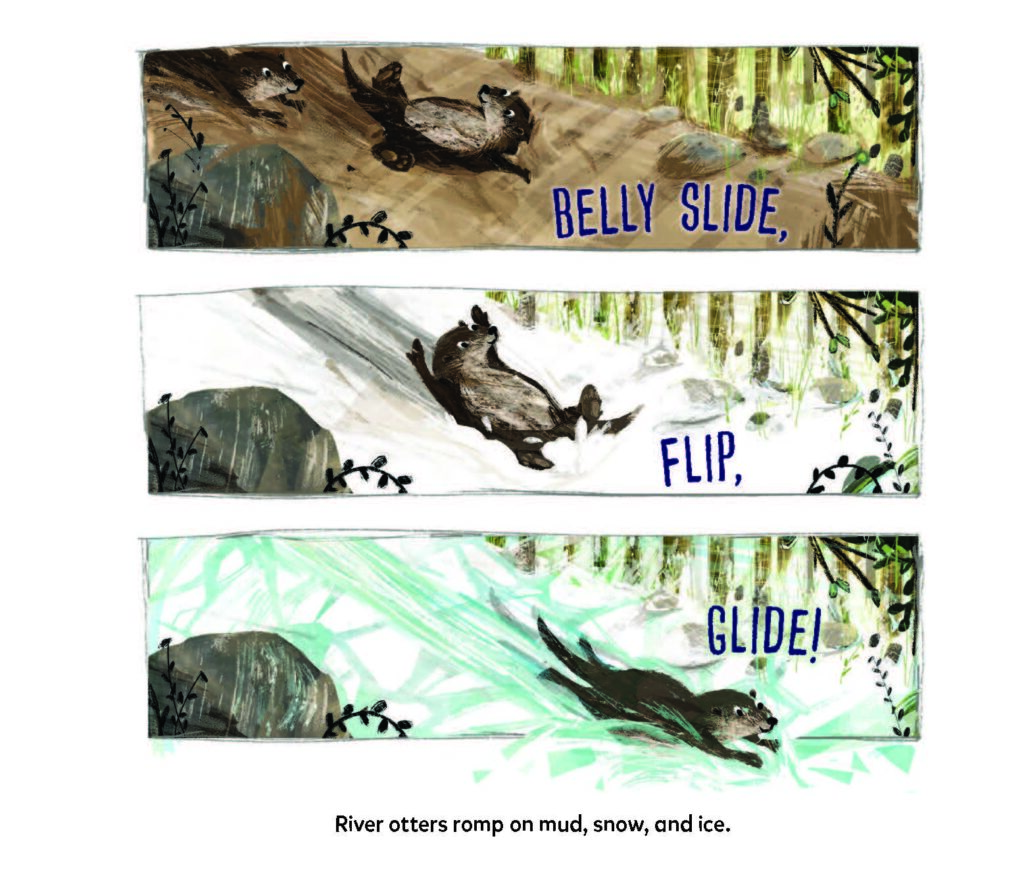
Mia Powell’s whimsical illustrations are cheerful and playful too!
Many expository titles, Play Like an Animal, and Terrific Tongues included, present readers with additional information and scientific explanations using layered text such as sidebars which both amplify and enrich the main text.
The sidebars for Play Like an Animal appear in playfully-colored orange boxes. Readers learn that when wolves and other canines play tug of war, it’s a way of practicing fair play, since they live in packs. When gorillas play tag, it’s also a way of practicing how to better communicate and cooperate.
Another thing I love about writing nature-y nonfiction is weaving in scientific vocabulary, details about diet, habitat, the predator-prey relationship, all kinds of things. Some of the vocabulary is poetic: when a Great horned owl mantles, it’s spreading its wings, to either protect its prey, or to appear larger to an enemy. Information can be woven directly into the narrative, as is the case with Whoo-Ku Haiku, or through the use of layered text in Play Like an Animal.
Nonfiction books also have the best back matter! I am a complete back matter nerd—I love to read back matter as well as write it. It’s also a great way to add cool facts and interesting information that didn’t quite make it into the main text. We’re lucky—we don’t have to completely let those darlings go!
The back matter for Whoo-Ku Haiku features more details on the great horned owl with fun headings like “Home Sweet Home,” explaining that it’s the most common owl in North America with a very wide range; “Whose Nest is Best” tells how Great horned owls use the abandoned nests of squirrels or other birds—they don’t make their own nests. My favorite is “Enormous Eyes”: though a Great horned owl is smaller than a toddler, it has eyes as big as an adult human’s. For the more fun comparison: if we had eyes as proportionately as large as they do, then our eyes would be as big as grapefruits!

The back matter in Play Like an Animal is a bit more subversive:it showcases the importance of play for intellectual, mental and physical health, and how play makes us all smarter—it helps us to problem solve, be creative, imaginative and empathetic, and learn to cooperate with each other.
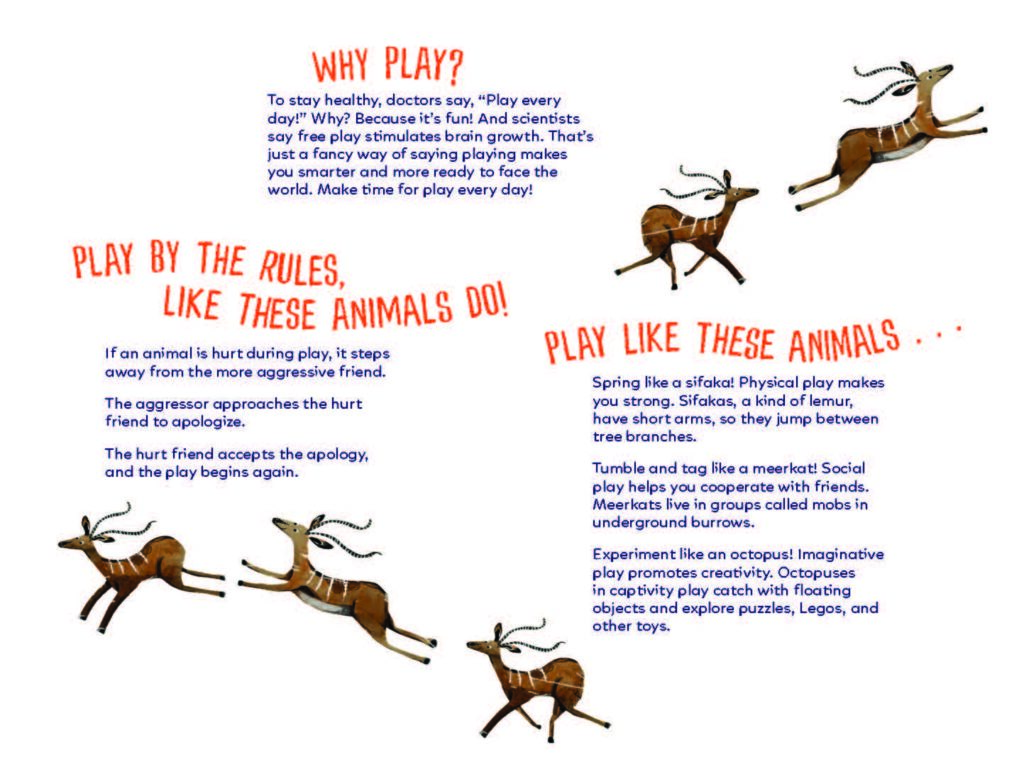
It’s fun, and when we play, we are learning all kinds of things too. Play for homework, I say—especially now! With the current pandemic intensifying our collective anxiety, play is essential. It’s a natural stress reliever, it helps us to be present, and to feel more empowered and less overwhelmed, even if it’s just temporary. Play is medicine. So is nature, for that matter.
Keep playing! Keep reading and writing nonfiction!
If you’d like to learn more about nonfiction texts, I highly recommend Melissa Stewart’s Celebrate Science blog.
And for wonderful book recommendations, check out Alyson Beecher’s Kid Lit Frenzy and Michele Knott’s Mrs. Knott’s Book Nook on nonfiction Wednesdays.
Be sure to comment to be entered into the giveaway: a copy of Whoo-Ku Haiku AND Play Like an Animal, courtesy of Penguin Kids and Lerner Publishing (US residents only due to postage cost—sorry!)
Maria Gianferrari is a picture book reading/writing, tea-drinking, dog-loving, birdwatching resident of Virginia. She writes fiction picture books that feature dogs, such as the forthcoming, To Dogs with Love (Roaring Brook) and nonfiction picture books about animals and nature like Be A Tree, to be published by Abrams in Spring 2021. You can learn more about Maria at her website.
Jill, here. Thanks, Maria. This was all just fabulous.
Meanwhile, I’ve randomly drawn THREE names to WIN copies of my new book, Where’d My Jo Go? Those names are: Dorothy Wiese, Susan Meyer, and Breanne Arnold. Thanks for entering, ladies!

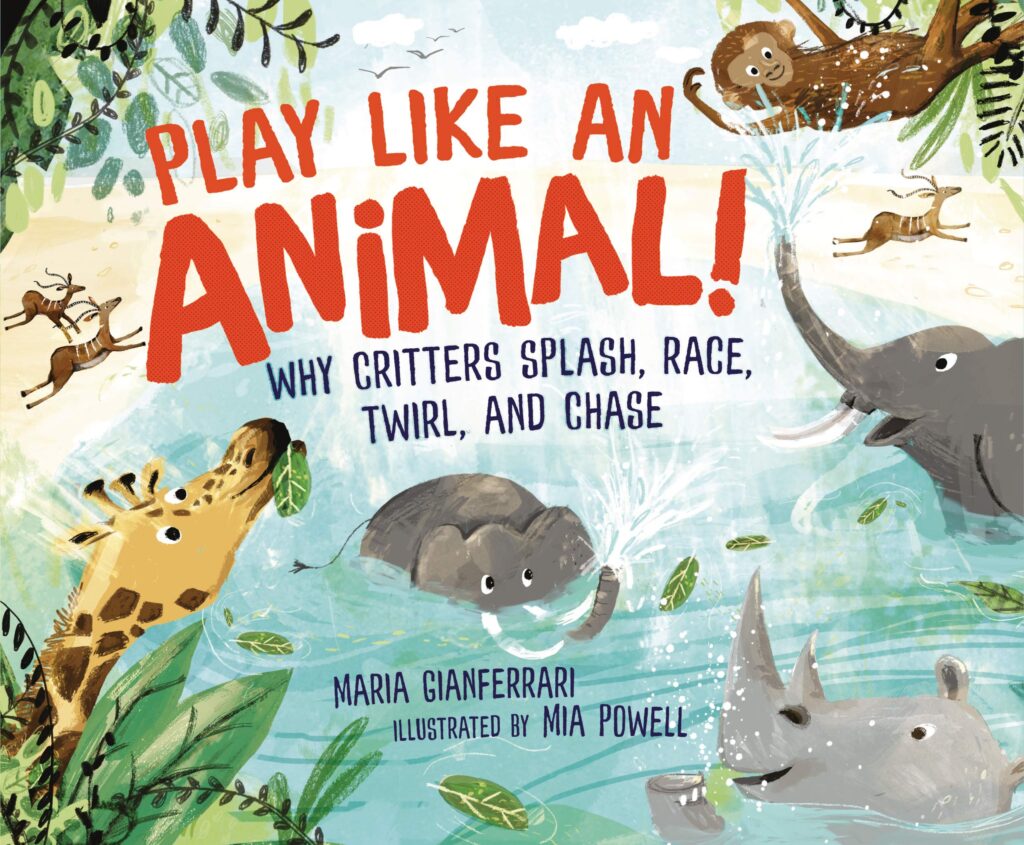

Great post! I love the lyrical voice in some of your books and the playfulness of the text in your Play Like an Animal book! I look forward to reading the Whoo-ku Haiku!
Thanks so much, Tina! I hope you & your family are safe & well!
Great post!! Beautiful and playful books!
Thanks, Lisa. Is this my friend, Lisa R??
Oh my! What an incredible source of tips for writing nonfiction—both expository and narrative. This post is like a free class! And you know how much I love your books! They are both fantastic reads!
Congratulations Maria! Play Like Animal is such a fun book to read aloud.
Woops–there’s something glitchy going on & I posted in the wrong place! Thanks, Ashley! Glad you enjoyed the book!
Thanks for the kind words, Deb–I miss you!
So cute and such fun books. Thanks for sharing. Now I want to play around with writing haiku.
I learned so much from your post, Maria! And your books are always a great marriage of wonderful words and beautiful illustrations!
Thanks so much, Teresa! Loved Queen of Physics, and am excited to read Bicycles 🙂
Thanks for the wonderful post, Maria! You’ve inspired me to start my day by writing some nature poetry. I love the lyrical voice in Hawk Rising and Coyote Moon, so I can’t wait to read Whoo-ku Haiku. And Play Like an Animal sounds like such a fun read. Thanks again!
Thanks for the kind words, Becky! Writing nature poetry sounds like the perfect way to start a day!
Wonderful interview! I can’t wait to get my hands on a copy of Whoo-ku Haiku. Not only is the Haiku lovely, you’ve given me something to think about as I work on a Haibun picture book I’ve been writing. Love the playfulness of the animals and I think my grands will love that one. Congratulations! Thanks for sharing with us. 🙂
Good luck with your book, Angie!
Does your library have an e-book version of it?
My very first poems I ever wrote as a child were about nature. Love your work! Congrats!
Mine too, Danielle! It’s hard not to be inspired by the natural world and its creatures!
Thanks Maria and Jill. These are fantastic books and great examples to study. I appreciate the deeper look at narrative vs. expository!
Thanks for commenting, Mary 🙂
These books look great, my twins would love them!
Thanks, Zachary! I hope your twins like the twin books 🙂
These books look great! Thank you for sharing!
Thanks, Ashley!
Great authorly insights here, Maria and Jill. Thank you!
Thanks, Carrie! Love your Stretch to the Sun as a tree and redwood fan 🙂
I enjoyed reading this post very much as I am trying to learn more about crafting picture books. I’m also a big fan of Maria too. Thank you for the excellent insight into your books.
You’re the best, Danielle :)!!
Wow, so much great advice to chew on here. Thank you for a simple, clear explanation for your approach two very different types of non-fiction texts. I wish I could say I’m on my way to the library to get my hands on these books right now, but we all know why that’s not true. At least I can put them on my request list and hope for the best. Thanks again!
I hear you, Marilyn. I am so behind with my picture book reading especially! Perhaps your local library has e-book versions, or an interlibrary e-loan system?
Thanks so much for having me here, Jill, since PB Builders is one of my favorite blogs :).
Wow–informative AND inspiring. Thank you for the post!!
Thank YOU for commenting, Lynn :)!
Loved this post, Jill and Maria. I have several of Maria’s books including the two giveaways 🙂 Thank you for the inspiration, tips, and links! You ladies rock.
Hello Charlotte!! Hope you’re well!
Good for you, Maria! Nonfiction should always be this much fun. If I were still employed as a reading specialist, I’d want your books in the hands of my struggling readers.
Thanks for the great tips for NF!
My pleasure, Tracy :)!
Terrific post! I’m bookmarking to refer to this one again.
Glad you enjoyed it, Buffy. Loved your snow-melting day book 🙂
Look at those adorable otters play! I could watch them all day long. This was a great post Maria, filled with your generous guidance, excellent resources and good advice for writers.
Please don’t enter me in the drawing though – I own and love these books already!
I love otters too!! <3 <3 <3
Thank you, Maria, for this insightful post. These two books look to be the perfect antidote to the blahs of late! Wishing you continued success!
Thanks for the good wishes, Carmela.
Thanks, Maria and Jill. Maria, I loved reading about your writing process, and how you approach narrative versus expository nonfiction.
Hi Rebecca–love your books & hope you’re well!
You rock, Maria! Thanks for this all-encompassing post on two types of nonfiction. I heard you speak at a Mid-Atlantic conference and have been enjoying your work ever since. I look forward to reading Animals that Play. Lucky me, I’ve been staying-at-home with Whoo-Ku Haiku!
Thank you for the kind words, Leann! Sorry I seem to have missed this before! Replying here is a bit glitchy for some reason.
Glad you’re enjoying Whoo-Ku!! <3
Great post, Maria! I love all that you shared. I too am a back matter nerd. It’s the best! The blogs you mentioned (and PBB, of course) are my go to ones as well. Thanks so much for sharing your process.
Hello Traci! Back matter nerds unite ;)!!
What a wonderful combo- nature and poetry! Can’t wait to see both books!
Nature + poetry = <3
I can see that you’ve used beautiful language in both books, even though the styles are quite different.
Very kind of you to say, Janet–thanks!
Great Post! I love your books!
Thanks very much, Angela!
Absolutely gorgeous books and I love the language.
Many thanks, Kaye :)!
I love the use of haiku for picture books. It’s such a digestible form of poetry for young readers!
Agreed, Joanna!! Distilling things to their most essential elements is fun!
Hello, Maria! So wonderful to get the backstory here! Congratulations on your two new beauties!
Hello back, and thank you, Linda!! I hope you are well!!
Congratulations, Maria! I have Hawk Rising and Coyote Moon and love them! I’m really excited to read Whoo-ku Haiku!
Thanks so much for saying so, Linda! You made my day <3!!
Maria, what interesting topics. We have a great horned owl in our woods in PA. I enjoyed this interview and the creative processes involved. One thing really stayed with me afterwards… you said, “ Another thing I love about writing nature-y nonfiction is weaving in scientific vocabulary, details about diet, habitat, the predator-prey relationship, all kinds of things. Some of the vocabulary is poetic: . “ YES OH YES! And then turn STEM to STEAM and take that poetry, and facts the kids write down, and put them to music, either of their creation, or to a folk tune or popular tune. This is so natural and I love the parallels of what I do and you do. And we are both nature geeks! Please enter my name into consideration for either of these interesting books. Stay well all!✌?
Nature geeks unite!! Have you seen your GHO, or do you just hear it? I had a chat with a GHO in our neighborhood–it answered my calls, but it didn’t get close enough for me to see it in the dark.
Wonderful post, Maria! Thanks so much for sharing your thoughts about process, structure, and voice in nonfiction. xoxo
Thanks & xoxo back, Laurie!
I instantly fell in love with both Hawk Rising and Coyote Moon because of the beautiful language you used in both books. I now use them as mentor texts for word choice during my writing lessons. I want my writers to see that rich language can be used when writing fiction and nonfiction. Whoo-Ku Haiku and Play Like an Animal were added to my “to read” list on Goodreads as soon as I heard about them. I can’t wait to read them and add them to my classroom library.
How kind of you to say, Jennifer–thank you so much!! What grade do you teach?
So much goodness in this post. All your titles are must reads, Maria! I’m especially interested in Whoo-ku. Will be referring back to your tips. Thank you! : )
Thanks, Bridget! I hope you will enjoy it!
Great post, Maria–this is awesome! I can’t wait to read both these books. Congratulations on two beautiful titles this year!
Thanks & be well, Laura!
A very informative post. Thanks, Maria, for sharing your books and relating the differences between expository and narrative nonfiction! Your books look amazing!
You’re welcome, Judy! Thanks for commenting!
Maria, I have benign love with your work since I first saw it in 2014 before Coyote Moon was out. I believe editor Emily Feinberg at Roaring Brook shared it. Wold love to win onewof you newest. Congrats and great post.
Hello Kathy!! I hope we’ll get to meet some day soon, perhaps with our mutual friend, Deb Shumaker :)!!
Thanks for sharing how you write different kinds of nonfiction. You books are incredibly engaging and I love how the form speaks to the topic.
Hello & thanks, Laura :)!!
Great points about narrative vs concept structures — I love what I see in your shared spreads of Whoo-Ku Haiku and can’t wait to read it and Play Like An Animal when my library and local bookstore open again.
Thanks for sharing! I’m looking forward to reading your books when local options are once again open. The information on the structure for your stories is particularly helpful! Since you write both fiction and nonfiction featuring animals, in your experience can a fiction piece with talking animals (who otherwise act realistically) include back matter? And is such a combination marketable with certain publishers? Thank you!
So sorry, Samantha. I overlooked your comment before!
Yes–absolutely! Back matter can be used both for fiction and nonfiction. I’m not sure it it might make it more marketable though. It would probably depend on the content, and if there were some kind of conceptual tie-in to something timely.
Thanks for the inspiring insights. I have to get my hands on Whoo-ku Haiku!
I seemed to have missed yours too initially, Kimberly–sorry about that!
I hope that you will enjoy Whoo-Ku 🙂
Perhaps your library may have e-book versions. It’s so hard to wait for all the books I want to read too, Val.
I love books on nature! How clever to use haiku!
Me too, Kathy :)!
Maria, I loved this post! Haiku is a favorite poetic genre of mine and the way you’ve applied it in your book about the Great Horned Owl is a perfect invitation to gently learn so much! PLAY LIKE AN ANIMAL has such fun backmatter! Looking forward to reading both in their entirety.
I hope that you will enjoy them, Charlotte :)!
I love your books, Maria. Also, I love back matter. I’m struggling with my book, and will pick it up again hopefully soon. Thank you for your inspiration.
Hi Virginia!! Thanks so much for saying so!! Good luck with your book! Sometimes putting it aside for a day or two helps.
Wow Maria! I loved seeing all these fantastic examples! The information about back matter is so helpful. Thanks for a great post. I look forward to reading all your new books!
Thanks, Melissa. Glad the back matter info was helpful :).
Congrats, Maria! I loved Hello Goodbye Dog, so I’m excited to read your latest books.
Awww–thanks so much for the kind words about Hello Goodbye Dog, Susan :).
Thank you for your helpful blog. Your books are now on my list formy grandkids!
I hope that they will enjoy them, Diane :).
I enjoyed this post and it has me thinking differently about a non-fiction piece I’m working on.
Good luck with your NF project, Leslie!
Brilliant! I can’t wait to check out these books.
Thanks, Lenora :)!
Congratulations, Maria! Terrific post and gorgeous books!
Many thanks, Jennifer! I am a fan of your art :)!
Thanks for sharing your insights on writing non-fiction, Maria. I love all the great topics being covered for younger readers and yours are definitely on my TBR !ist.
I hope you will enjoy them, LeeAnn!
Thanks for sharing such wonderful insights on your nf works Maria!
Thanks so much, Suzanne! Looking forward to reading your Gwendolyn Brooks book :)!
Many thanks. Amazing!
Thank you!
I love Hawk Rising. Looking forward to seeing these new ones. Congrats!